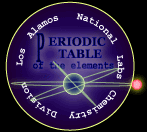

| Atomic Number: | 20 | Atomic Radius: | 197.3 pm | ||
| Atomic Symbol: | Ca | Melting Point: | 842 �C | ||
| Atomic Weight: | 40.08 | Boiling Point: | 1484 �C | ||
| Electron Configuration: | [Ar]4s2 | Oxidation States: | 2 |
(L. calx, lime) Though lime was prepared by the Romans in the first century under the name calx, the metal was not discovered until 1808. After learning that Berzelius and Pontin prepared calcium amalgam by electrolyzing lime in mercury, Davy was able to isolate the impure metal.
Calcium, a metallic element, is fifth in abundance in the earth's crust, of which it forms more than 3%. It is an essential constituent of leaves, bones, teeth, and shells. Never found in nature uncombined, it occurs abundantly as limestone, gypsum, and fluorite. Apatite is the fluorophosphate or chlorophosphate of calcium.
The metal has a silvery color, is rather hard, and is prepared by electrolysis of fused chloride and calcium fluoride ( to lower the melting point).
Chemically it is one of the alkaline earth elements; it readily forms a white coating of nitride in air, reacts with water, burns with a yellow-red flame.
The metal is used as a reducing agent in preparing other metals such as thorium, uranium, zirconium, etc., and is used as a deoxidizer, desulfurizer, or decarburizer for various ferrous and nonferrous alloys. It is also used as an alloying agent for aluminum, beryllium, copper, lead, and magnesium alloys, and serves as a "getter" for residual gases in vacuum tubes, etc.
Its natural and prepared compounds are widely used. Quicklime (CaO), which is made by heating limestone that is changed into slaked lime by carefully adding water, is the great base of chemical refinery with countless uses.
When mixed with sand, it hardens mortar and plaster by taking up carbon dioxide from the air. Calcium from limestone is an important element in Portland cement.
Solubility of the carbonate in water containing carbon dioxide is high, which causes the formation of caves with stalactites and stalagmites and is responsible for hardness in water. Other important compounds are the carbide, chloride, cyanamide, hypochlorite, nitrate, and sulfide.
Title Picture: Fossils are commonly calcified organic matter.

Sources: CRC Handbook of Chemistry and Physics and the American Chemical Society.
Last Updated: 12/15/2003,� Chemistry Operations
Operated by the University
of California for the US Department
of Energy
|
Help
| Copyright � UC 2003 | Disclaimer